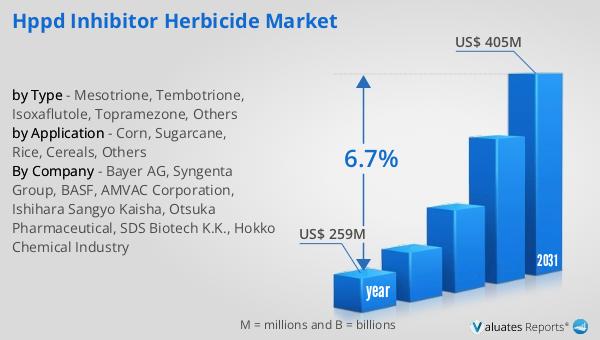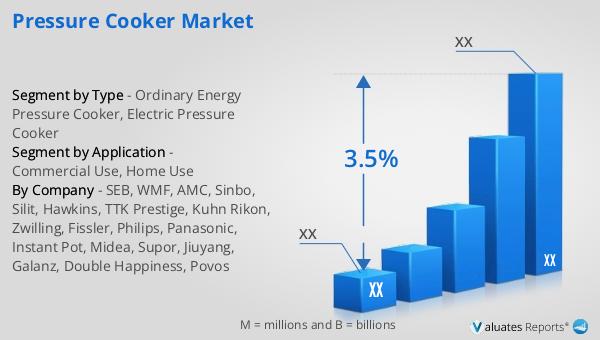What is Global HPPD Inhibitor Herbicide Market?
The Global HPPD Inhibitor Herbicide Market is a specialized segment within the agricultural chemicals industry, focusing on herbicides that inhibit the enzyme 4-hydroxyphenylpyruvate dioxygenase (HPPD). These herbicides are crucial for controlling a wide range of broadleaf and grass weeds, which can significantly impact crop yields if left unmanaged. HPPD inhibitors work by disrupting the synthesis of carotenoids, essential pigments that protect plants from damage caused by sunlight. Without these pigments, weeds are unable to survive, thus allowing crops to thrive. The market for these herbicides is driven by the increasing demand for high crop yields and the need for effective weed management solutions. As agricultural practices evolve and the global population continues to grow, the demand for efficient and sustainable herbicide solutions like HPPD inhibitors is expected to rise. This market is characterized by ongoing research and development efforts aimed at improving the efficacy and environmental safety of these products. Companies operating in this space are continually innovating to meet the diverse needs of farmers across different regions and crop types. The Global HPPD Inhibitor Herbicide Market is poised for growth as it addresses the critical challenge of weed management in modern agriculture.

Mesotrione, Tembotrione, Isoxaflutole, Topramezone, Others in the Global HPPD Inhibitor Herbicide Market:
Mesotrione, Tembotrione, Isoxaflutole, and Topramezone are key active ingredients within the Global HPPD Inhibitor Herbicide Market, each offering unique benefits and applications. Mesotrione is widely used due to its broad-spectrum activity against various weed species. It is particularly effective in controlling weeds in cornfields, where it helps maintain high yields by eliminating competition from unwanted plants. Mesotrione works by inhibiting the HPPD enzyme, leading to the depletion of carotenoids in weeds, which ultimately results in their death. Tembotrione, another prominent HPPD inhibitor, is known for its rapid action and effectiveness against a wide range of broadleaf and grass weeds. It is often used in combination with other herbicides to enhance its efficacy and broaden its spectrum of control. Tembotrione is particularly valued for its ability to control weeds that have developed resistance to other herbicide classes, making it a crucial tool in integrated weed management strategies. Isoxaflutole is another important HPPD inhibitor, recognized for its pre-emergence and early post-emergence activity. It is commonly used in corn and soybean fields to control a variety of weeds before they can establish themselves and compete with crops. Isoxaflutole's mode of action involves the inhibition of the HPPD enzyme, leading to the disruption of carotenoid biosynthesis and the eventual death of the target weeds. Topramezone is a highly effective HPPD inhibitor known for its post-emergence activity against a broad spectrum of weeds. It is often used in corn and sugarcane fields, where it provides excellent control of both broadleaf and grass weeds. Topramezone's rapid action and long-lasting residual control make it a popular choice among farmers seeking to protect their crops from weed competition. In addition to these key active ingredients, the Global HPPD Inhibitor Herbicide Market also includes other compounds that contribute to the overall effectiveness of these products. These additional ingredients are often used in combination with the primary HPPD inhibitors to enhance their performance and provide a more comprehensive weed control solution. As the demand for effective and sustainable herbicide solutions continues to grow, the development and use of HPPD inhibitors like Mesotrione, Tembotrione, Isoxaflutole, and Topramezone are expected to play a critical role in modern agriculture.
Corn, Sugarcane, Rice, Cereals, Others in the Global HPPD Inhibitor Herbicide Market:
The usage of Global HPPD Inhibitor Herbicides spans several key agricultural areas, including corn, sugarcane, rice, cereals, and others. In corn production, HPPD inhibitors are particularly valuable due to their ability to control a wide range of weeds that compete with corn plants for nutrients, water, and sunlight. By effectively managing weed populations, these herbicides help ensure high corn yields and improve overall crop quality. The use of HPPD inhibitors in cornfields is a common practice among farmers seeking to maximize their productivity and profitability. In sugarcane cultivation, HPPD inhibitors are used to manage weeds that can significantly impact crop growth and sugar content. Weeds in sugarcane fields can lead to reduced yields and lower sugar recovery rates, making effective weed control essential for maintaining the economic viability of sugarcane production. HPPD inhibitors provide a reliable solution for controlling a variety of weed species in sugarcane fields, helping farmers achieve optimal yields and sugar content. Rice production also benefits from the use of HPPD inhibitors, as these herbicides help manage weeds that compete with rice plants for essential resources. Weeds in rice fields can lead to reduced yields and lower grain quality, making effective weed control a critical component of successful rice cultivation. HPPD inhibitors offer a targeted approach to weed management in rice fields, allowing farmers to protect their crops and maintain high yields. In cereal production, HPPD inhibitors are used to control a variety of weeds that can negatively impact crop growth and yield. Weeds in cereal fields can lead to reduced grain quality and lower overall productivity, making effective weed management essential for successful cereal cultivation. HPPD inhibitors provide a reliable solution for controlling a wide range of weed species in cereal fields, helping farmers achieve optimal yields and grain quality. In addition to these key agricultural areas, HPPD inhibitors are also used in other crop production systems where effective weed management is essential for maintaining high yields and crop quality. As the demand for efficient and sustainable herbicide solutions continues to grow, the use of HPPD inhibitors in various agricultural sectors is expected to increase, providing farmers with the tools they need to manage weeds effectively and sustainably.
Global HPPD Inhibitor Herbicide Market Outlook:
In 2024, the global market for HPPD Inhibitor Herbicides was valued at approximately $259 million. This market is anticipated to expand significantly, reaching an estimated size of $405 million by 2031. This growth trajectory represents a compound annual growth rate (CAGR) of 6.7% over the forecast period. The increasing demand for effective weed management solutions in agriculture is a key driver of this market growth. As the global population continues to rise, the need for higher crop yields and efficient agricultural practices becomes more pressing. HPPD inhibitors offer a reliable solution for controlling a wide range of weeds, making them an essential tool for modern farmers. The market's expansion is also supported by ongoing research and development efforts aimed at improving the efficacy and environmental safety of these herbicides. Companies operating in this space are continually innovating to meet the diverse needs of farmers across different regions and crop types. As a result, the Global HPPD Inhibitor Herbicide Market is poised for significant growth, providing farmers with the tools they need to manage weeds effectively and sustainably.
| Report Metric | Details |
| Report Name | HPPD Inhibitor Herbicide Market |
| Accounted market size in year | US$ 259 million |
| Forecasted market size in 2031 | US$ 405 million |
| CAGR | 6.7% |
| Base Year | year |
| Forecasted years | 2025 - 2031 |
| by Type |
|
| by Application |
|
| Production by Region |
|
| Consumption by Region |
|
| By Company | Bayer AG, Syngenta Group, BASF, AMVAC Corporation, Ishihara Sangyo Kaisha, Otsuka Pharmaceutical, SDS Biotech K.K., Hokko Chemical Industry |
| Forecast units | USD million in value |
| Report coverage | Revenue and volume forecast, company share, competitive landscape, growth factors and trends |
